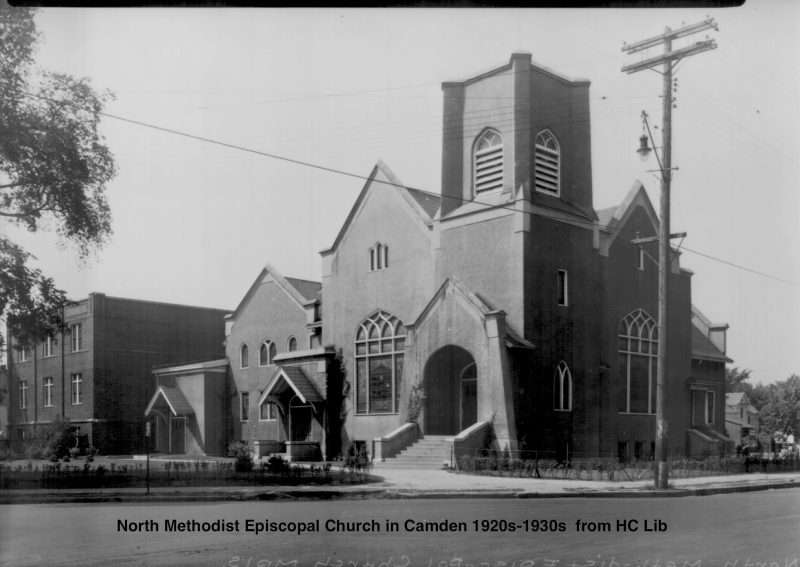
The history of the beginnings of North United Methodist Church and that of the Camden area of North Minneapolis are intertwined. On March 26, 1852, a circuit rider preacher named John Ware Dow and his wife Susan moved onto their land claim of about 120 acres in this area thus making them the first non-Native settlers here. They would build a one room log shanty at about what is now 44th and Humboldt Aves N. One day later on March 27, 1852, John C. Bohanon came to this area. Throughout the summer of 1852 a number of other families moved into the area we now know as Camden. The Reverend Dow would invite these families to his log cabin to pray and sing, and he would preach sermons. During this same time, there were families settling in the areas north of Shingle Creek. Rev. Dow also held services there using the log cabins of settlers in that area. He was the preacher for these two pioneer settlements that eventually became known as Shingle Creek (Camden) and Brooklyn Center.
During the Methodist Conference year of 1853, a man named John Plummer and his family staked their land claim in what became Brooklyn Township. Plummer and Dow worked together and for quite a while, services and prayer meetings would be held in the homes of these two men. It was during this same conference year that a Methodist Class was officially organized with eight charter members in the log cabin of John Ware Dow. Some of these charter members lived in Brooklyn (later Brooklyn Center) and others lived in Shingle Creek (later Camden Place). In 1859 they divided into two classes. The Shingle Creek class being led by the Dows, Bohanons, Farnhams and Gillespies. Both groups continued to meet in peoples’ homes until the Brooklyn Methodists built their first church in 1866. The Shingle Creek Methodists continued to meet in homes and in 1865 added Sunday school. In 1866 James M Gillespie built a barn and offered to have the church services and Sunday school held there. The barn was used for a year until the large one room Red Schoolhouse was built about where the tennis courts currently are in Webber Park and services were then held there.
In October 1878 the Reverend Boyd Phelps was appointed to serve both the Brooklyn and Shingle Creek Methodists. The Shingle Creek group often talked about building a church and Rev Phelps helped them get the project started. John C and Sophia Bohanon donated the land at what is now 44th and Fremont and where the church remained. Rufus and Eliza Farnham, John Wesley (son of John Ware) and Mary Dow, along with other members donated lumber, bricks, work and money. The church, which cost about $2500, was dedicated on November 30, 1879. At the time, it was out in the country amongst farms since the northern border of Minneapolis was 26th Ave N. A parsonage was built for the church in 1885 and the church stopped sharing a pastor when Reverend HJ Van Fossen came and the church became a totally separate congregation. It was at this time that the presiding elder, Franklin Chaffee, suggested that the church be named North Church and the name was adopted.
When the Reverend Robert R Aitchison came to North Church in 1887, he thought the area deserved a better name than Shingle Creek (it was called this because of a shingle factory near the creek). While the US Post Office refused to change the name, when the Soo Railroad came through and built a depot, Rev Aitchison convinced them to use the name Camden Place after his hometown of Camden, New Jersey. The post office changed their name to Camden Place in 1888. The same year, the Minneapolis northern city limit was moved to 53rd Ave N where it still is today.
By 1908, the congregation had grown to about 220 members and was out growing its pioneer building. A new church was built and dedicated on December 11, 1910 and the old church was incorporated into the new one and became the chapel. The Sunday school continued to grow so a brick education building was added next to the church in 1924. In 1963 it was decided that the church would remain in North Minneapolis rather than move to the suburbs like some other churches were doing and that a new building was needed. The earlier church building was torn down and a new church was built and connected to the remodeled education building and dedicated on Palm Sunday 1964. In 1994 a new addition was added with an elevator to make it easier to get to the social hall in the basement.
The last regular service of North United Methodist Church was held on Christmas Eve 2022. The church building was deconsecrated and the congregation disbanded on May 7, 2023.
The Camden community and this pioneer church share a lot of history.
A note: Much of this history was taken from the work of the late Elmer Tupper who not only researched and wrote down North United Methodist church history but who also gave lectures and slide shows of this history.


